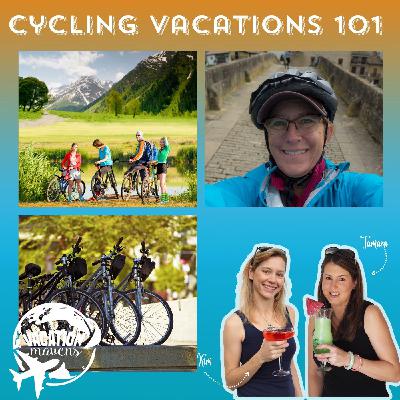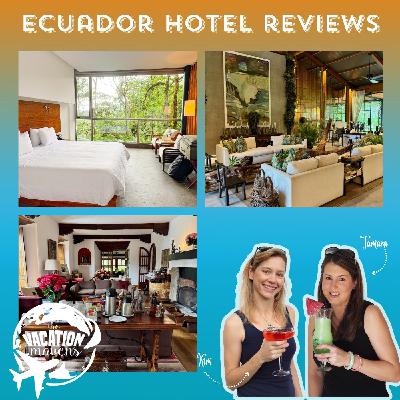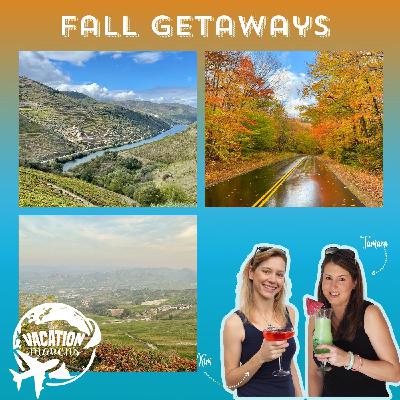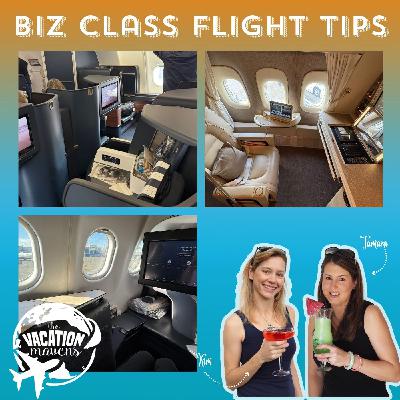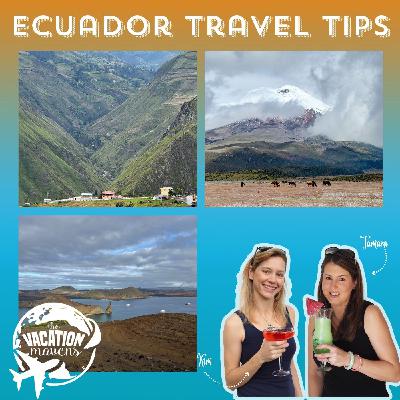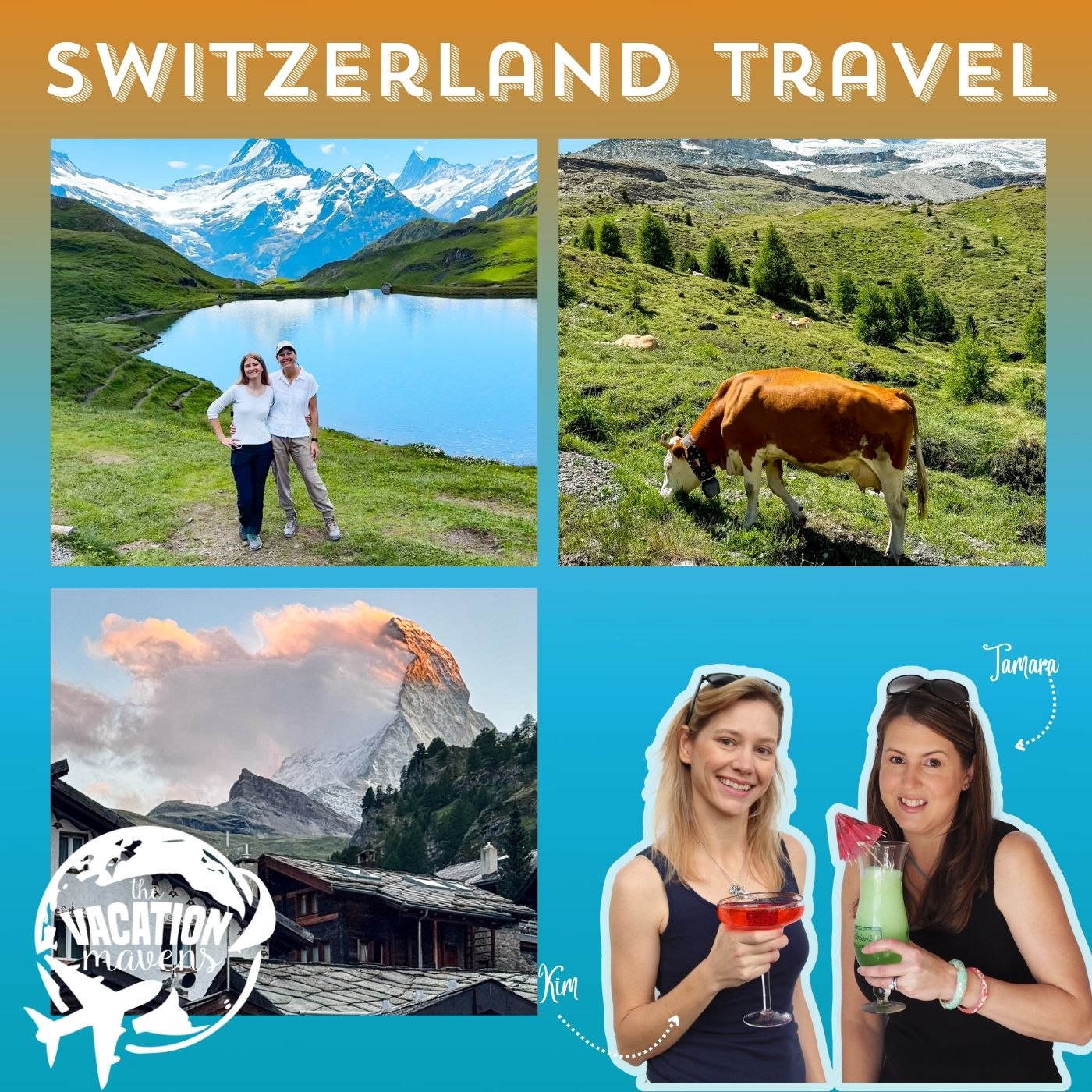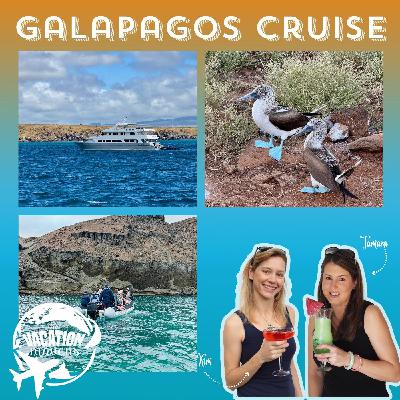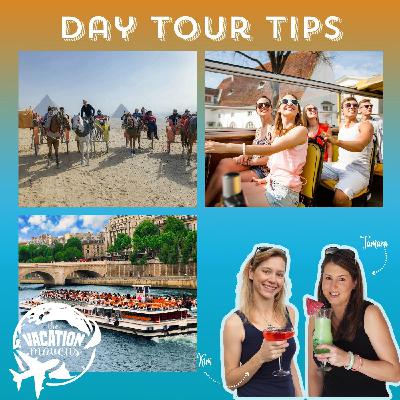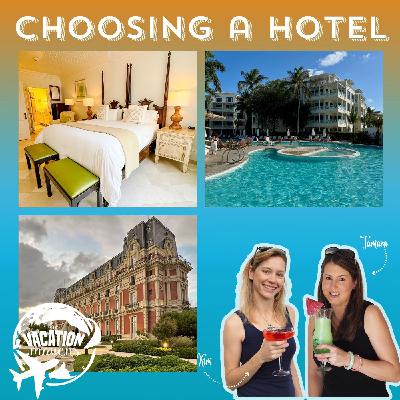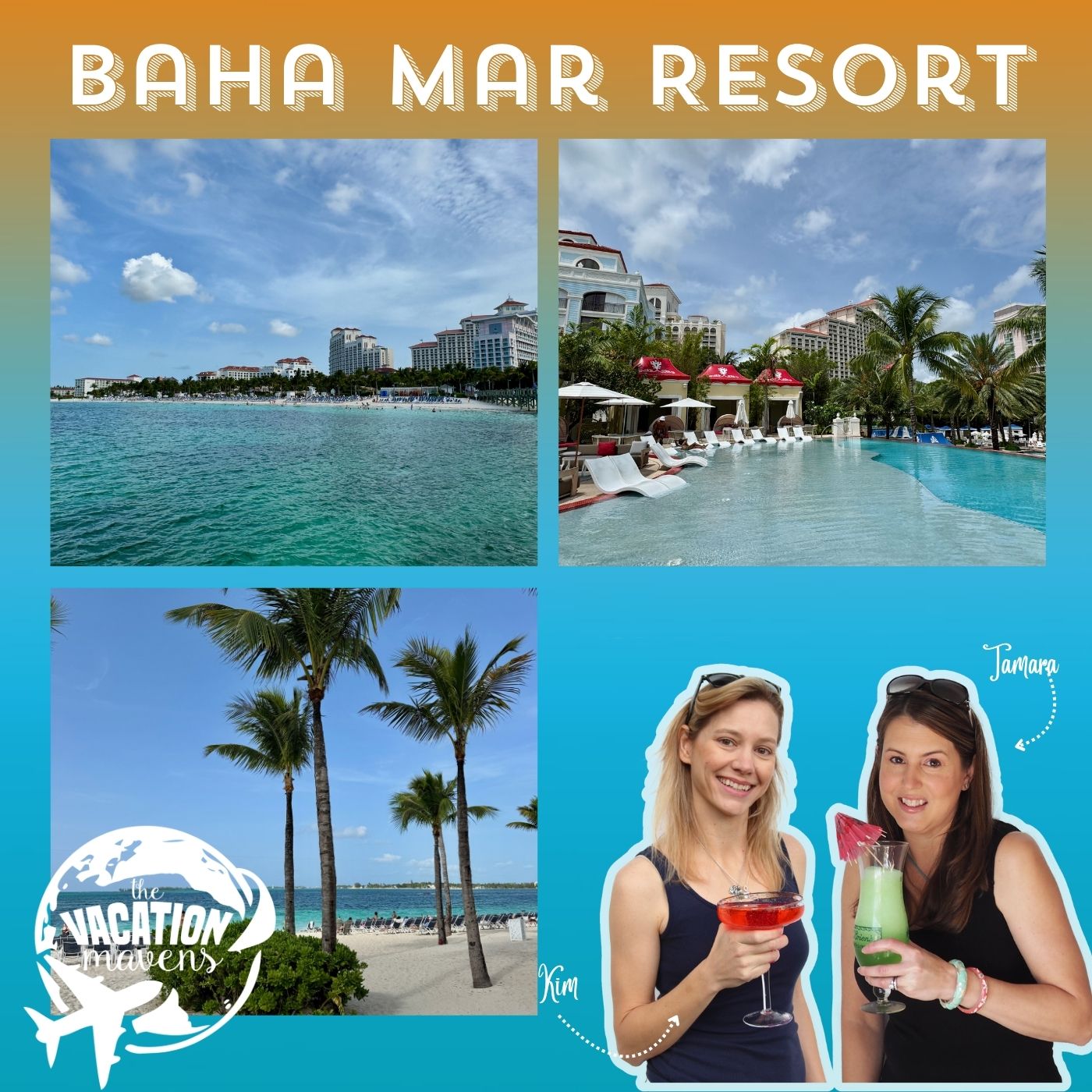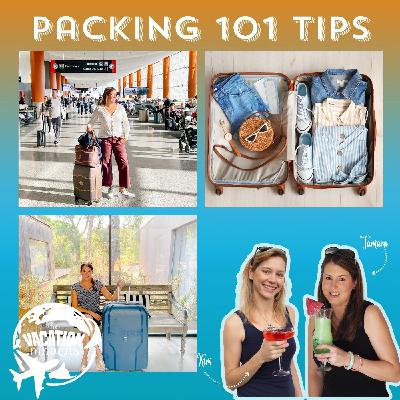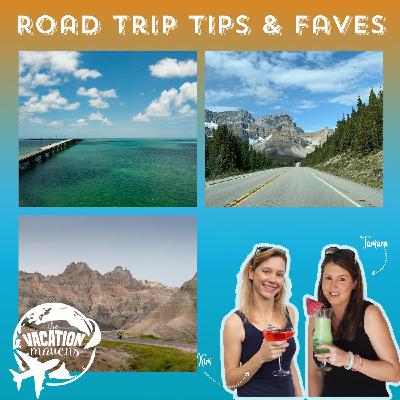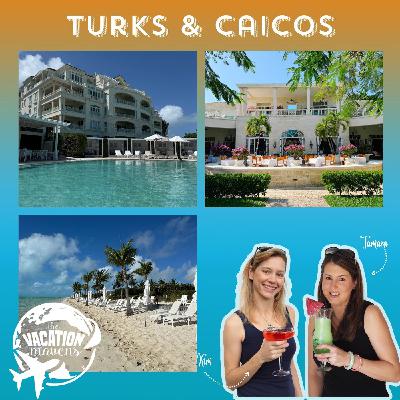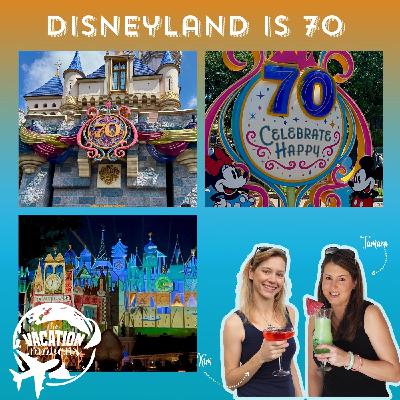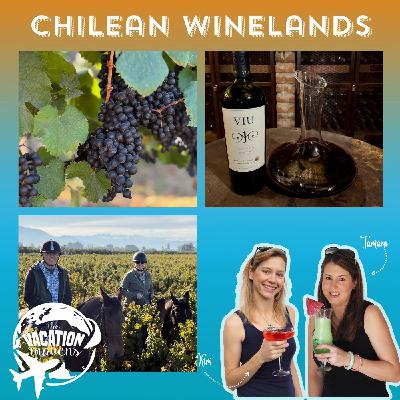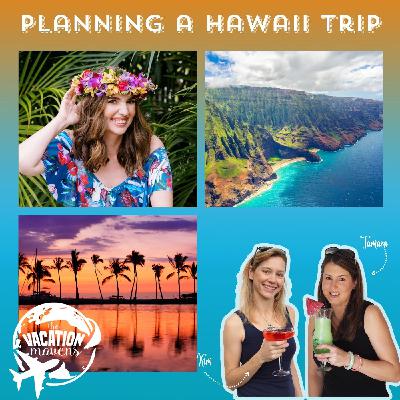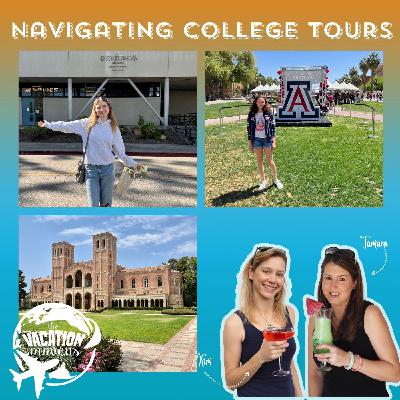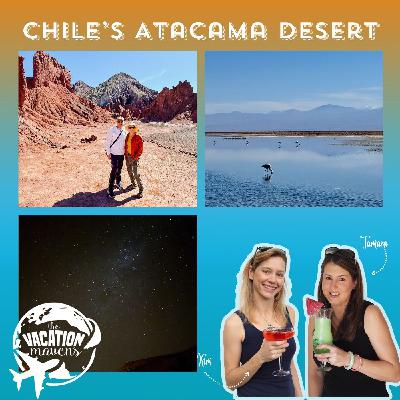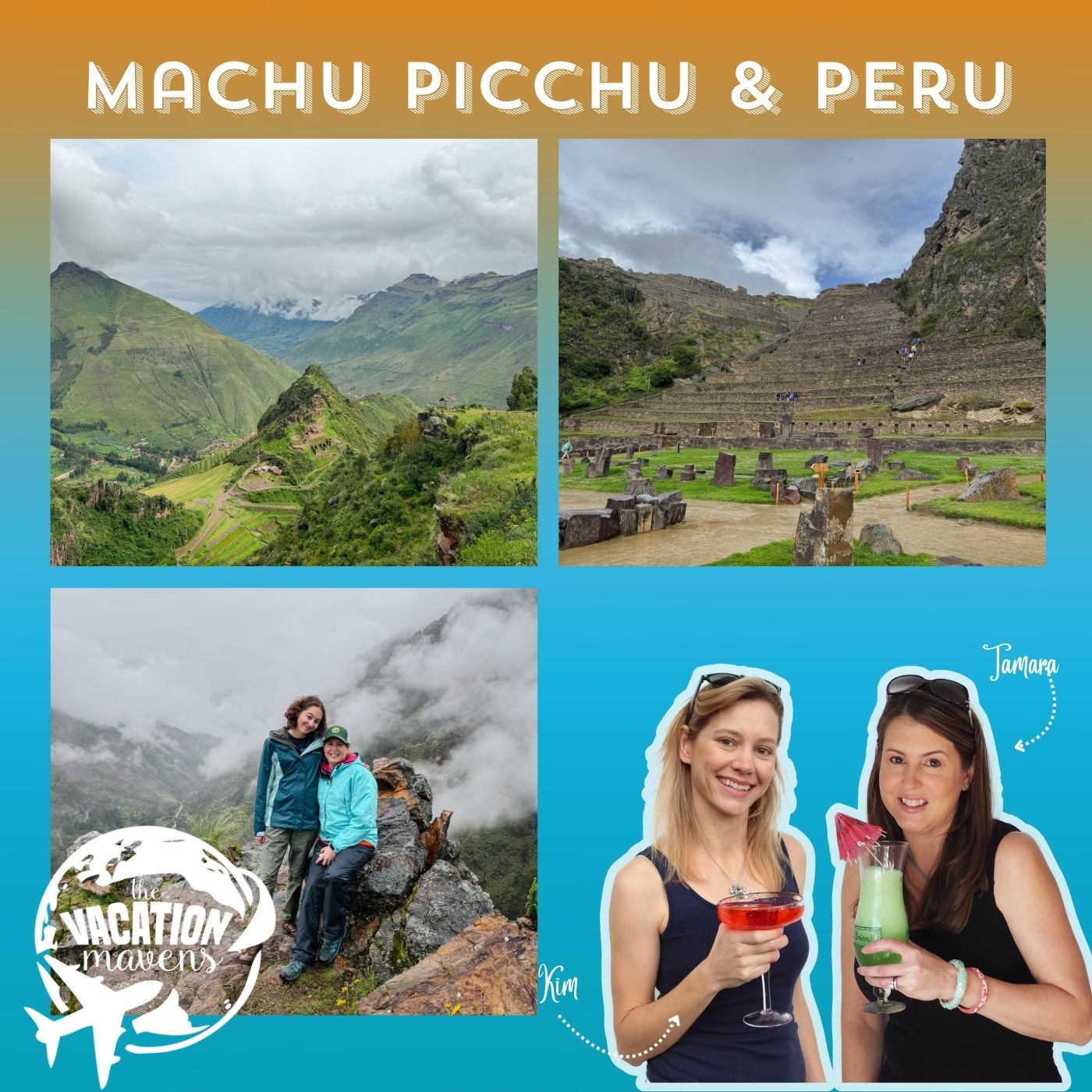Discover Vacation Mavens Travel Podcast
Vacation Mavens Travel Podcast

Vacation Mavens Travel Podcast
Author: Kim Tate and Tamara Gruber
Subscribed: 194Played: 8,556Subscribe
Share
© 2016-2025 Vacation Mavens, all rights reserved.
Description
Vacation Mavens is a travel podcast offering practical travel tips and destination inspiration from two moms who know how to plan the perfect trip. Hosted by Kim Tate, from StuffedSuitcase.com, and Tamara Gruber, from YourTimetoFly.com, we have over 40 years of combined travel expertise.
We share our favorite vacations from road trips to cruises, European adventures to theme parks. Whether you are planning a family vacation, romantic couples trip, or mom getaway we have the tips and tricks to make memories that will last a lifetime.
We share our favorite vacations from road trips to cruises, European adventures to theme parks. Whether you are planning a family vacation, romantic couples trip, or mom getaway we have the tips and tricks to make memories that will last a lifetime.
266 Episodes
Reverse
In this episode of Vacation Mavens, we are joined by adventure traveler and blogger Sherry Ott of OttsWorld. We dive into what it takes to plan a successful cycling vacation — everything from choosing destinations and tour types, to picking the right gear, training beforehand, and recovering well. Whether you're a biking newbie or looking to level up your next bike‐based trip, this one’s packed with insights and practical advice. Sherry Ott is a long-time travel blogger (since 2006) specializing in adventure travel, especially for women. She started leading small group trips in 2018, including unique “cat lady tours” in Japan. Sherry began serious biking during the pandemic, upgrading to gravel bikes and exploring both domestic (U.S.) and international routes (Chile, France, Prince Edward Island). She is passionate about making bike travel accessible, safe, and fun for all skill levels. Episode Highlights Planning & Choosing a Trip Decide between guided and self-guided tours — guided trips offer support and community, while self-guided give you more flexibility. Research destinations with strong bike infrastructure (trail networks, signage, support). Check elevation, distance, and trail type (paved vs. gravel) to match your comfort level. Look for tour companies that provide e-bike options if you want extra support. Read reviews, ask about group size, and confirm whether you can bring your own gear (seat, mirror, pedals). Training & Fitness Prep Start riding regularly at home to build saddle time and comfort. Practice on terrain similar to your trip (gravel, hills, road). Work on balance, confidence, and endurance. Don’t underestimate elevation — even moderate climbs can feel tough over multiple days. Safety & Comfort Gear Always bring your own helmet for the best fit and safety. Pack a rear-view mirror (handlebar or helmet mount) for traffic awareness. Wear bright, high-visibility clothing so drivers and riders can see you. Bring rain gear and layers — weather can shift quickly. Prioritize comfort over style on the bike. Recovery & Wellbeing Use compression socks or leggings (e.g. Vim & Vigor) to reduce muscle fatigue. Hydrate often and refuel with snacks during rides. Allow time for rest and stretching after long days. Be mindful of long flights post-trip — keep circulation flowing with compression wear and movement. Helpful Resources Adventure Cycling Association – maps, routes, and trip planning tools. Tour operators like Experience Plus, Biketours.com, and Backroads. Tourism boards for bike-friendly regions with trail networks and infrastructure.
We recently covered Tamara's Galapagos cruise and also some tips for visiting Ecuador, but this week we are digging into where to stay in Ecuador. Tamara gives a recap of her trip including some mini hotel reviews for Hacienda La Danesa, Mashpi Lodge, and Hacienda Zuleta. Episode Highlights Tamara spent 17 nights in Ecuador including 5 nights in the Galapagos, 1 night at Hacienda La Danesa, 2 nights in Cuenca, 1 night near Cotopaxi, 3 nights in Quito, 2 nights in the Mashpi Lodge, and 2 nights at Hacienda Zuleta You wouldn't want to move around this much but Tamara wanted to see a lot of the country Hacienda La Danesa is a good pairing with the Galapagos It is 1.5 hours from Guayaquil It is on a large property with a farm, cacoa plantation, and a teak plantation on site It is an all-inclusive property. There are only seven accommodations and there is also the family home, as it is still family run The lodge is very beautiful with a bar, restaurant, lounge area, and library The design and style is very beautiful and perfect for those that really appreciate nice design Included activities include milking the cows, biking with a local guide, river tubing, a visit to the cacao plantation, and a chocolate tasting and making workshop Additional activities include horseback riding, cooking classes, and off-site excursions For a Cloud Forest experience, especially if you don't want to go all the way out to the rainforest, Mashpi Lodge is a good option to pair with a visit to Quito or Cotopaxi It takes about two hours to get to Mashpi Lodge and the last hour is on a very rough dirt road and not great if you have neck or back issues Mashpi Lodge is really great for birdwatchers Tamara wouldn't recommend it for families with very young kids as it is pretty active 2-3 nights is perfect for the Mashpi Lodge There are morning and afternoon excursions and you can also opt into a night hike Each evening there are presentations from naturalists or biologists It is an all-inclusive experience with meals and activities (not alcohol or spa services) The Sky Bike gives a "birds eye" view of the Cloud Forest but it is hard work to pedal across the cable Hacienda Zuleta is located in the mountains about 1.5-2 hours from Quito It is a historical, family-run, colonial-style hacienda that offers a very authentic feeling stay This is also an inclusive stay with meals and activities The town is known for embroidery and there is a handicraft market every Sunday Some of the activities include hiking, biking, horseback riding (additional), visiting the Condor rehabilitation center, embroidery classes (additional), visits to the cheese making factory, tours of the kitchen garden and grounds, watching the sheep or cows be milked, and more The food is fantastic at Hacienda Zuleta Tamara also spent two nights at Casa Gangotena in central Quito, which is a fantastic luxury hotel which is well-located in the historic old town Related Episodes Galapagos cruise
For this episode, we are joined by Nicky Omohundro of Little Family Adventure and the Untethered and Wanderwise podcast to talk about some of our favorite fall getaways. With over 15 years creating digital content and as a USA Today 10Best family travel expert, Nicky Omohundro operates a nationally syndicated travel website, Little Family Adventure, and award-winning podcast, Untethered & Wanderwise. As a licensed travel advisor and empty-nester with international trips planned, she inspires women over 45 to reclaim their wanderlust and travel independently. Episode Highlights Here are a mix of road trips, international getaways, and local staycation ideas for the fall. Eureka Springs, Arkansas in the Ozark National Forest. Eureka Springs is a cute Victorian town in the heart of the Ozark Mountains. It is a pretty drive and peak fall color is late October. If you like haunted history, the Crescent Hotel is supposed to be one of the most haunted hotels in the country. Vermont is quintessential New England charm and beautiful fall color. You have beautiful country inns and bed and breakfasts. Top towns include Stowe, Woodstock, and Manchester. Hotels book up very early for peak weekends and prime foliage is late September - early October. Victoria, British Columbia is easy to access from the Victoria Clipper from Seattle. The harbourfront is beautiful and Butchart Gardens. It is also a unique wine region. September is a great time to go. Piemonte in Northern Italy. Fall is white truffle season and wine harvest season. You do need to book hotels in advance, especially near Alba because of the Alba White Truffle Market, but otherwise the towns aren't crowded. Portugal is an amazing destination in October, including the Porto and Douro Valley wine region. For sunshine, head to Alentejo where it has started to cool off and you can enjoy wine tasting and relaxation. Oklahoma City - right in the middle of the country but often overlooked, it makes a great weekend getaway. Pumpkinville is one of the best pumpkin patches in the country. You also have great food, art, and history including western and indigenous culture. Next year is the 100 year anniversary of Route 66 and Oklahoma City has the longest stretch of the highway. The old Santa Monica Pier Ferris Wheel is now set up in Wheeler Park in Oklahoma City. Finger Lakes, New York - it is beautiful in the fall with cute small towns, wine trails, and special events. The area also has a lot of agritourism including apple farms, pumpkin patches, cheese makers, dairies, and even alpaca farms. Boone, North Carolina on the Blue Ridge Parkway. Great scenic drives or hiking on Grandfather Mountain and a mile-high swinging bridge. You can fly into Asheville and drive to Boone. It is also a fun college town. West Coast road trip along Highway 1 from the Washington / Oregon coast, through the sand dunes and into the Redwoods. Some of the small shops in the tourist towns may close during the week as it gets later into the fall. Related Episodes New England travel Portugal girls trip to Douro Valley and Porto Piemonte in Northern Italy West Coast road trip
Today we are talking about what happens when you turn left on the airplane and fly business class! Now that Kim and Tamara have flown business class on many airlines including Delta One, Aer Lingus, TAP Airlines, Emirates, Finnair, Condor, Avianca, and others. Whether you are booking on points or paying cash, there are some things that you need to know first. Episodes Highlights Research what aircraft is flying the route you are looking to buy because the business class can vary dramatically depending on the plane and the layout Keep in mind that the airline can still change the aircraft after booking The airline will provide you with the aircraft type and should list if it is a lay flat seat or a suite You can also research how often the aircraft is switched out Also look at YouTube plane reviews for the specific route that you are looking at booking You may want to splurge on business class on longer flights, for example longer than eight or nine hours Consider if you have an overnight flight, you may want to upgrade to business class Keep in mind that if the flight is leaving in the early evening, it may still be hard to sleep Also, dinner service can really cut into your potential sleep time so on a shorter flight (e.g. from the east coast to Europe), it may not be worth it If you want to book with points, you can also use a paid service or use paid apps to try to find the best reward flights If you are booking on points, keep in mind that you still need to pay taxes and fees on most flights and some airports (such as London Heathrow) are very expensive If you have Avios points, you can move them to different programs but other partner programs you can combine Business class is different than first class. Many airlines don't have first class, such as Qatar or Delta, but others have first class, business class, premium economy, and economy When you are traveling business class, you have access to the priority lane for checking your bags Some airports offer a priority security lane as well When traveling business class, you have access to the airline lounge (if available in the airport) You also get to board early and they will typically bring you a welcome drink Keep in mind that your under-the-seat space is limited in business class and some airlines or aircraft set ups have better storage than others The airline will also provide you with a small amenity kit with a sleep mask, moisturizer, lip balm, and other items They will also provide you with a comfy blanket and pillow and some will make up your bed for you Our favorite business class experiences include Qatar, Turkish Airlines, and JetBlue Mint Our favorite lounge experiences have been the Virgin lounge in Heathrow, the Business Class lounge for Turkish Airlines in Istanbul, and the Garden in Doha, and the British Airways lounge Related Episodes How to choose your seat on the airplane What to know about airline fees Airport travel tips
We recently talked about Tamara's trip to the Galapagos but today we are talking more about the logistics about traveling to Ecuador and some travel tips. Tamara spent 17 nights in Ecuador, including 5 nights in the Galapagos and found it a warm and welcoming country with beautiful and diverse landscapes. Amazing Ecuador helped Tamara organize her trip. Episode Highlights Most flights from the U.S. come into Quito or Guayaquil It is only 3.5 hours from Miami There are many regions including the Cloud Forest, Rainforest, volcanoes and mountains, National Parks, Galapagos, and more Tamara spent: 5 nights in the Galapagos, 1 night at Hacienda La Danesa, 2 nights in Cuenca, 1 night in Cotopaxi National Park, 3 nights in Quito, 2 nights in the Cloud Forest at the Mashpi Lodge, 2 nights at Hacienda Zuleta It helps to work with someone to figure out your priorities and build an itinerary around your interests Generally you want to spend at least two to three nights in each place Cuenca is a UNESCO heritage city with plenty of outdoor adventure nearby too Cotopaxi is at a higher elevation, making hikes challenging If you just have a week, fly in and out of Guayaquil and do the Galapagos and Hacienda La Danesa Safety - you need to be very careful after dark in Quito and other cities and beware of pickpockets. Don't walk around after dark, especially alone Ecuador uses the U.S. dollar as their official currency but most places also take credit cards but you will want small bills for tipping and the handicraft markets Many of the hotels are all-inclusive with meals and some activities Ecuador is a huge exporter of roses and through some regions you will see many roadside stands of 25-50 roses for less than $5 Tamara recommends getting a driver because the roads are not very well marked, some aren't in the best condition, Google Maps isn't reliable, and drivers are very aggressive There are a range of four star boutique hotels and luxury hotels Ecuadorian food is very fresh and utilizes year-round produce of veggies and fruit Most meals start with a soup and then have a salad or vegetables. Fish and ceviche is quite popular. Quinoa is a popular grain You shouldn't drink the tap water in Ecuador but the produce at good restaurants and hotels are washed in filtered water Guinea pig is also popular in Ecuador as it is in Peru Chocolate and coffee are also grown in Ecuador and very popular Ecuador is the most densely populated country in South America If you have liked Costa Rica or Belize, you will probably also like Ecuador Related Episodes: Galapagos cruise Mother-daughter trip to Peru Winelands of Chile Chile's Atacama Desert
Kim and her daughter Mia just got back from a mother-daughter trip to Switzerland. They celebrated her high school graduation with a grad trip and since Mia loves mountains and she was already going to be in France with a school trip, Switzerland was her top choice! They visited Geneva, Zermatt and the Jungfrau Region because they really wanted to focus on the mountains. Altogether they spent eight nights in Switzerland and they moved around a lot. The itinerary included: 1 night in Geneva 2 nights in Zermatt to see the Matterhorn 2 nights in Grindelwald 2 nights in Wengen 2 nights in Lucerne If you are going to Switzerland and you really want to spend time in the mountains, skip Geneva and Lucerne and focus more on the smaller towns, not the cities. Their favorite town was Zermatt for hiking and also wine tasting. Grindelwald was the other favorite because of the hotel and the view of Eiger. Some of the activities included: Visit the old town in the cities (e.g. Geneva) Hiking (which are harder than you might expect even on trails described as easy, use Google Maps to see elevation, buy or bring hiking poles if you can and are checking a bag) Cable cars (which are pricey) Matterhorn Glacier (you can also ski even in the summer) Alpine slides / mountain coaster / ziplines The train is a great way to get around the country and if you use a Swiss Rail Pass you also get transportation on some of the cable cars (but not all). It makes it very easy because you don’t need to worry about buying tickets. First class will give you more seating options and it is less crowded so it is quieter. It is hard to use the trains if you have large luggage as some of the trains are more for locals/commuters. Try to pack light if you can or use a luggage forwarding service. It is better to stay longer in each destination as you spend a lot of time transiting up and down the mountains via train/cable car. Basing yourself in Murren or other smaller towns ends up with a lot of time waiting for transportation. It makes more sense to stay in Grindelwald, Interlaken, or Lauterbrunnen. When planning a trip, be sure to plan at least six to nine months in advance if you want to stay in town and at the better hotels. Also, when considering different hotels, the hospitality is wonderful but look closely at the amenities that are offered. Most don’t have air conditioning but it wasn’t needed in the mountains. Some hotels have screens on the windows but not all and there are a lot of flies and some mosquitoes. Keep in mind that shops close early (6-7 pm) and that busses also stop running by 7:00 pm in small towns. Hotels and meals are very expensive in Switzerland, especially now that the dollar is weak against the CHF and Euro. Main entrees are 30-50 CHF per person, salads 12-19 CHF, and beer was cheap but wine was expensive. To save money, you can buy wine or beer at the grocery store to enjoy before you go out. Drink sizes are also very small. The food is a lot of fondue, cheese, pasta, raclette, and chocolate. Other regions might have more regional specialties. Otherwise there are a lot of burgers and international cuisine. If you do have allergies, there are a lot of peanuts and other nuts being served as a snack or included in dishes. Credit cards can be used almost everywhere. In all the tourist areas, everyone spoke English. They were less accommodating in the city or non-tourist establishment. Be sure to pack and wear sunscreen. It is hard to find places to refill a water bottle so you may want to carry your own snacks and drinks.
Tamara is just back from a 5-night Galapagos Islands cruise on board the Galaxy Yacht. She was hosted on this trip by Galaxy Expeditions but all opinions are her own. Galaxy Expeditions operates a number of yachts in the Galapagos and also can arrange for land travel in Ecuador, Peru, and Bolivia. The Galaxy Yacht has eight cabins for a maximum of 16 passengers. Episode Highlights You need to fly to the Galapagos from either Quito or Guayaquil in Ecuador (1.5 - 2 hours) At the airport before leaving the mainland, you need to purchase your tourist card and have your luggage inspected and zip tied to protect the islands from bringing in invasive species A delegate from Galaxy Expeditions met her at the airport to walk her through the process Once you arrive in the Galapagos, you need to pay an entrance fee to support the National Park ($200 per person) and they reinspect luggage, which takes about an hour on arrival You then meet your group and take a bus to the port where you load onto zodiac boats to get to the yacht A 5-night cruise was a nice amount of time to reach many of the islands and see a ton of wildlife but longer would be more tiring and could get a little repetitive Most of the cruises in the Galapagos are 16-32 or maybe 50 passengers If you are prone to motion sickness, you will feel it, especially at night as they moved from place to place The engines are also loud so bring ear plugs or a sound machine to help drown it out I'd recommend bringing Dramamine or seasickness meds as well as sleep aids On board, there were two solo travelers, a few couples and a mother-daughter duo from Germany, Switzerland, Spain, and the USA The food was really good and breakfast was usually a buffet and lunch was a buffet or served and there were usually two options for a dinner entree They also served light snacks and fresh juice or tea after excursions Excursions and meals are included (alcohol is not) Excursions start early and stay busy all day. The first excursion of the day is usually at 6 - 7 am There are typically two hikes per day and one to two snorkeling excursions per day They provide wet suits and snorkel gear on board The week started busy and got a little less so towards the end, which was appreciated Tamara saw sea turtles, fish, penguins, frigate birds, blue, red, and brown-footed boobies, sea lions, iguanas, and Galapagos tortoises There is a naturalist guide on board that leads every excursion and provides so much information about the wildlife and ecosystem The islands Tamara visited on Galaxy Yacht itinerary C are: Santa Cruz, North Seymour, Bartolome, Santiago, Genovesa, South Plazas, and San Cristobal Related Episodes Land-based trip to the Galapagos Mother daughter trip to Machu Picchu Atacama desert in Chile
On this episode we are sharing some of our top tips for finding good guided day tours or special experiences when you are traveling. We will walk through how to find them, how to book, and tips for taking city tours. Episode Highlights On your arrival day, don't schedule a guided tour since your plane may not be on time and you may be tired from traveling. If anything, look at doing something impromptu like a hop on hop off bus or just walking around on your own. On your first full day in a city, it is helpful to take a guided tour to get the lay of the land and get recommendations from a local Some common tour booking platforms are Viator and Get Your Guide. Just understand that these are platforms advertising different tour companies or operators, the tours aren't actually run by Viator or Get Your Guide Often you can find the tour operator name on the listing and if you want, you can look up that company and book direct to support small businesses Be sure to read the details of what is included on the tour and whether or not you are going inside points of interest or just seeing it from the outside Pay attention to the meeting points and end point to choose ones that are fairly convenient for you based on where you are staying Make sure you look at the reviews and ratings before booking a tour Look at the number of people that are on the tour. It will often list the maximum number of passengers on a tour. Some tour companies, like Shore Excursions, offers a back-to-ship guarantee, which is great if you are booking cruise excursions Look at what tickets are included Put in the date when you are looking at pricing as it can vary depending on the season, day of the week, etc. Also, go through the full checkout screen to see what additional fees or taxes are added when building your budget Some other tour companies that we like are: Walks (or Take Walks), Livtours (small groups), Devour Tours (food tours), Eating Europe (food tours), Tours by Locals, The Tour Guy, and City Experiences You can also Google "free walking tours" to find pay as you go or tip-based walking tours by locals Always plan to arrive 10-15 minutes before the tour starts to check in Map out the meeting place before you go and know how you will get there Know if you need to be dressed a certain way (headscarf, covered shoulders, etc) or if you can't bring bags/backpacks, etc. Private tours are great for families or if you have mobility issues because it is easier to customize them Don't forget to tip a good tour guide. Group tour tip is typically $5 per person and a private tour is $10-20 per person if it is a half day or full day Have small bills handy for tipping Rick Steves has great audio tours for Europe, GPS My City has self-guided tours, and VoiceMap is another app for self-guided audio tours that are more cost-effective than a guided tour.
What should you look for when choosing a hotel, and what are some pitfalls you can try to avoid? Get ready for summer travel with this week's episode full of tips and laughs. Episode Highlights Pay attention to the bathroom layouts when viewing photos and reviews as a new hotel trend has been for more open bathroom layouts or glass doors/walls which may not be great for families or friend groups Hotels are getting better at sustainability initiatives but many are just paying lip service so if this is important to you, look for companies truly dedicated to environmental issues and offer things like bottle refill stations If you want to check out the location of the hotel, look at the Google Street view to see more what the area is like Keep in mind that suburban hotels off the highway are more likely to offer free parking, laundry facilities, and free breakfast When booking city hotels, make sure that it is located near public transportation but avoid hotels near train stations or bus stations When selecting a room, look at the square footage to compare the various room categories Keep in mind that when you are traveling internationally, it is hard to find rooms with two queens or doubles. It is even harder to find rooms that sleep five. Typically the rooms will have a double/king or two twins Sofa beds are not always clean so always ask for clean linens, just keep in mind that you will need to make them up yourself Accessible rooms sometimes have lower closets, which might not be great for longer dresses, and the showers might have roll in showers and the floor of the bathroom can get really wet Request a room location away from the elevator / ice machine and a higher floor if near a loud highway Connecting rooms have thin doors and there is a lot of noise that comes through so put in your special request "no connecting room door" Be sure to read reviews and look out for red flags about noise, cleanliness, location, and service Bring a sleep mask or something to cover the glowing appliances and lights in the room Travel with a white noise machine Look out for daily resort fees and high city taxes Some brands or boutique hotels offer happy hours or cookies throughout the day Don't expect upgrades - book the category that you want Check out what the parking situation is and whether or not it is indoors or outdoors. Parking garages will sometimes list the clearance height Tipping housekeeping for good service is appreciated so it helps to carry some smaller bills
Tamara is just back from a multi-generational trip to the Grand Hyatt Baha Mar. If you have ever wondered what it is like to stay at one of the popular Baha Mar Resorts, now is your chance to get the scoop and see if it is really the vacation of your dreams or not. Episode Highlights: This was a multi-generational trip with 14 people ages 17-83. There were a lot of considerations when choosing a destination including budget, activities, direct flights, and mobility issues. Tamara also considered the Hyatt in Aruba, the Hilton Zemi Beach House in Anguilla, and the Westin or Kimpton Seafire in Grand Cayman. There are three hotels within one resort at the Baha Mar and it has multiple restaurants, making it possible to stay for a week and eat somewhere different every night without taking cabs into town. The food is really expensive at the Baha Mar so you need to build that into the budget as it is inline with going out for a nice dinner in a big city, which is similar to many other island resorts. The three hotels are: Rosewood Baha Mar - luxury property SLS Baha Mar - good for couples, friends, and more of a party scene Grand Hyatt Baha Mar - good for families and more affordable There is also a "Reserve" section of the Grand Hyatt Baha Mar with suites and lounge access that is a hotel within a hotel You fly into Nassau and you fill out a form on arrival and then the immigration line was quite short. They pre-arranged hotel transfers through the concierge. There are many pools within the Grand Hyatt but if you don't reserve a cabana, sunbed or premium lounge chair it could be hard to find chairs, especially if you want a larger group to be together. They rented a cabana at the Nexus Club, which has an indoor section with a couch, television, fridge, and a full bathroom. It also had a sun bed, a table and chairs with an umbrella, and use of two in-pool loungers. It was a private pool just for those renting cabanas or staying at a certain room category that included a hot tub. It also had its own bar and food service. The beach isn't deep but it is longed and it is lined with 4-6 rows of lounge chairs packed in together and the beach was quite busy even in June. There is also a waterpark that is included for guests with some big slides and a lazy river, as well as a good restaurant. You can do paddle boarding and snorkeling and there are also paid motorized water sports and there is an activities desk that arranges excursions and day trips. The Baha Mar also has a kids club with daily activities and there are flamingos that do a "parade" every morning. The food at Baha Mar was very good and even Tamara was impressed. Regatta is where they serve a huge breakfast buffet but it costs about $44 per person. Because Tamara is a preferred partner with Hyatt Prive, she was able to get the following perks and amenities: Free breakfast for 2 people per day per room $100 per room resort credit $50 per room beverage credit automatic upgrade within 24 hours of booking There are many pool bars serving food for lunch and there are also food trucks by the beach. You need to pre-book dinner reservations and they cover the gamut from Italian, Asian, Chinese, Steak, Mediterranean, and some celebrity chef restaurants like Cafe Boulud and Marcus Fish and Chop House (from Marcus Samuelson) In Tamara's opinion, the Baha Mar is better suited for families with teens or adults versus with younger kids as the casino is really the center point of the resort. Related Episodes: Where to stay in the Turks & Caicos Everything you need to know about Beaches Turks & Caicos Sonesta Maho Beach St. Maarten Caribbean cruise Where to go in the Caribbean Planning a Barbados vacation Planning a Grand Cayman vacation
Get ready for your summer vacation and future travel with these expert packing tips! From carry-on to checked bags, here are some things to keep in mind when packing for your next trip. Episode Highlights: Use a packing list! It helps you not forget critical items. Start creating your packing list early in your Notes app Kim has an outfit planner that you can sign up for on Stuffed Suitcase Pay attention to your itinerary to figure out what you need to bring for each activity Also pay attention to the weather forecast for your destination Try to minimize the number of shoes that you bring on a trip Try on your outfits while packing and take a picture of yourself so that you remember what you put together (with shoes, accessories, etc.) You can also put the picture into your notes app with notes about what day you were going to wear it to remember Packing cubes with compression can be great for saving space You can pack the cubes by destination/stop on the trip or daily outfits or just pack all your pants together, all your shirts together, etc. If you are flying on an international carrier, make sure to look up their baggage rules to understand the size and weight of carry on and personal items Even domestic carriers have different weight limits If you are buying new luggage, buy the matching packing cubes that fit perfectly Look for packing cubes that zip to a rectangle and not lumpy Gonex and Eagle Creek can be great brands to try Lay flat bags are great for toiletry bags Travelon makes a good organizer for your electronics Vodka in a spray bottle can help refresh clothes Bring a travel scale to check baggage weights Related Episodes Packing tips for family travel
It is summer road trip season so it is time to recap some of our best road trip tips from preparing, planning, packing, and more. Plus, we share some of our favorite road trips. Episode Highlights Before you head out on a road trip, make sure your car has been serviced recently and check the tires to make sure the pressure is correct. You may also want to top off your fluids and use the bug windshield washer fluid. Bring a go-to kit with wipes, sanitizer, tissues, lip balm, moisturizer, sun screen, and eye drops. Also bring a couple of extra baggies or ziploc bags. Bring a trash bag for the front and back (or for each kid) and empty the trash at each stop. Bring a small cooler and ice pack that you can refreeze each night for left overs and snacks. Have a specific spot for your snacks that can be refilled when needed. Use a car freshener or car air purifier to help keep food smells away. You may want to consider a AAA membership and bring your card with you. For longer road trips, consider bringing a carry on bag with a duffle bag instead of a larger checked bag. Use a duffle bag to transport what you need in and out each night. It is good to have one overnight bag for toiletries and pajamas for everyone that always goes in. Bring a laundry bag that you can put your dirty clothes in each day in your car or larger suitcase. Plan an overnight stay at a place that has laundry facilities. When choosing where to stay, consider staying just off the highway where you are more likely to find a chain hotel that has free breakfast and free parking (and laundry facilities). Plus it is easy to get on and off the highway. Some of the chains like Best Western have summer promotions for multiple stays. Some apps to have are Gas Buddy, Road Trippers, and of course Google or Apple Maps. Google Maps is also good at showing you how busy attractions are at different times of the day. For road trips in less-populated areas, bring a road atlas or paper maps (you can get free maps at AAA if you are a member) Maine Coast road trip - read the full post here: https://we3travel.com/boston-to-bar-harbor-a-maine-coast-road-trip-itinerary/ Florida Keys road trip - read more here: https://yourtimetofly.com/key-west-girls-trip/ Canadian Rockies road trip - read more here: https://we3travel.com/canadian-rockies-vacation-itinerary/ West Coast road trip - read more here: https://stuffedsuitcase.com/west-coast-road-trip/ Road trip packing list: https://stuffedsuitcase.com/pack-car-road-trip/ Related Episodes West Coast road trip Southwest Grand Circle road trip Oregon Coast road trip California road trip Midwest road trip Family road trip tips
Tamara recently took a travel agent FAM trip to Turks and Caicos and spent two nights at The Palms and two nights at The Shore Club. She also visited many other properties and today she shares her insights into each to help you decide where to stay in Turks and Caicos. Episode Highlights Turks and Caicos is known for its beautiful beaches and not for all-inclusives or as a party island Most of the hotels have great accommodations for families with 1, 2, 3-bedroom accommodations and up (including villa rentals) When arriving, be prepared for a long wait at passport control/immigration. Expect about an hour and longer on the weekends. When departing, leave 2-3 hours to get checked in and wait in the security line. There isn't a lot of room in the gate area but there is an area upstairs that has more space. To save time at the airport, you can pay for Fast Track access starting at $75 per person, each way. Private transfers from the airport are about $150 each way, but cabs can be $30+ per person for shared taxis. Taxis throughout the island are priced per person and are pricey. It is about a 15-20 minute drive from the PLS (Providenciales) to most of the hotels The Palms is on Grace Bay Beach (the most famous beach on the island). It is a luxury hotel with a lush, garden-like setting right on the beach. The style and decor is similar to Sandy Lane in Barbados, a colonial or plantation style. Tamara stayed in a one-bedroom suite oceanfront, which was huge with a full kitchen, living room, laundry, dining room, large balcony, bedroom with tons of closet space, and one and one-half bathrooms. They recently did a renovation at The Palms of rooms but also of the pool area and added a new pool/beach restaurant and pool bar (including a swim-up bar). The restaurants at The Palms were very good. Parallel 23 is fine dining and Sisi is modern Mexican. The Palms also has one of the best spas in the Caribbean The high season is during Festive (winter holidays) and President's Day weekend. The low season would be July-September Pricing in the Caribbean is quite high. The Shore Club is across the island on Long Bay Beach. There is a beach-to-beach package so that you can split your week vacation between the two properties. Long Bay Beach is breezy and very popular for kite surfing. The beach itself is narrow but long and The Shore Club has plenty of space to spread out. The water here is very calm and you can walk out very far, especially at low tide. Shore Club is also a luxury hotel and it has a sophisticated feel. There are villas and multi-bedroom accommodations that would be amazing for a girls' trip or multi-generational vacation. The one-bedroom oceanfront suite is huge and great for families with teens because there is a study that has a pull-out couch, full bathroom, and closets and a door that closes off from the rest of the space. There is another pull out couch in the living room. There is a sushi restaurant and a comfort food restaurant, plus pool bars and restaurants. There is a shuttle between the properties and also the four-star Sands property and guests have signing privileges for all the restaurants. The Alexandra Resort is a four-star, all-inclusive on Grace Bay next to The Palms with multi-bedroom suites and restaurants The Wymara Resort has a South Beach, sexy vibe that would be great for couples and honeymooners but the rooms are a bit smaller The Ritz-Carlton is a high-rise hotel with a smaller beach. The second tower is for Ritz-Carlton Residences and you can't use or earn points for the Residences. They are building an Andaz and St. Regis on Turks and Caicos now too. The H20 Resort on Long Bay Beach is a small boutique hotel that is good for people that are independent travelers and enjoy watersports as they have a kite surfing school and tons of rentals. Tamara is going back to Turks and Caicos in the fall for a Family Travel Association conference at Beaches Turks and Caicos (stay tuned!!) On Thursday nights there is a fish fry with food trucks, music, and artisans/souvenir vendors. The Junkanoo band performs and it is such a lot of fun. You can island hop by ferry or plane (but there is a separate terminal for domestic flights) You can also go scuba diving, snorkeling, charter a boat for fishing or island hopping, or boat out to the tiki bar off Long Bay Beach.
Kim recently took a quick trip to her happy place, Disneyland, to attend a special media preview of its 70th anniversary celebration. This yearlong celebration features new entertainment from fireworks to parades, special celebratory food items, decorations throughout the park, and fun interactive activations. There are also promotional package deals available through Kim's partner Getaway Today. Learn more here and use code 'Stuffed Suitcase" when purchasing to save an additional $10 off a 2+ night vacation package. Learn more about Disneyland's 70th celebration foods here: https://disneyparksblog.com/dlr/disney-eats-disneyland-70th-celebration-foodie-guide/ See more of the special events and decorations on Kim’s Insta post: https://www.instagram.com/p/DJskA7ZJRKD/ Related Episodes: Girls' trip to Oceanside, California and Disneyland Disneyland and Irvine, California Disneyland Holidays Planning a trip to Disneyland Disneyland travel tips
If you like culinary or wine travel, you need to put the Chilean Winelands on your travel bucket list. Tamara just came back from a two-week trip to Chile including the Atacama Desert and the Winelands. Episode Highlights: The wine regions are south and west of Santiago It is easy to drive through these regions but it is still recommended to get a driver for days when you are doing wine tasting Two hours south of Santiago is the Colchagua Region that is known for its red wine including Malbec, Bordeaux blends, Cabernet Sauvignon, and Carmenere. One hour west of Santiago is the Casablanca Region, which is closer to the coast, and is more known for its white wines like Sauvignon Blanc and Chardonnay. She stayed at the Vibo Wine Lodge in Colchagua. This is a small boutique property on the Viu Manent Vineyards near Santa Cruz. It has individual lofts or tiny homes spread out throughout the vineyards. Another popular place to stay in this region is Clos Apalta, which is a Relais & Chateaux luxury property. Vibo Wine Lodge includes breakfast in the coffee shop on property and they also have two other restaurants, the Rayuela Restaurant and the Vibo Wine and Food Studio. On property you can hike, borrow bikes, enjoy the pool, go wine tasting or set up horseback riding. They also did a wine tour with Colchagua Wine Tours, which was only $125 for a day with a private driver (you pay for the tasting separately.) Tamara enjoyed wine tasting at Montgras Winery and Maquis Winery. They had a nice lunch at Fuego Apalta on the Montes Winery (but she didn't like the wine at Montes.) Tastings of the "icon" wines, which are the top wines, are about $40-50 per person. Clos Apalta Residence is also an excellent place to go for lunch or dinner and you can go wine tasting at the winery. In Casablance, they stayed at La Casona, which is a hacienda which has been converted to a hotel on the grounds of the Matetic Vineyards. This was all-inclusive because there isn't a lot nearby to eat. But the menu doesn't change so it gets repetitive if you are there for any length of time. The package also includes excursions and they did a biodynamic wine tour and tasting, mountain biking, and hiking. They also offer horseback riding and excursions to towns. They took a day trip to the coast and visited Pablo Neruda's house. Related Episodes: Chile's Atacama Desert Wine tasting in Northern Italy
If Hawai'i is on your bucket list, you need to listen to this episode with Hawaii travel expert Marcie Cheung. Marcie is a family travel blogger and mom of two who's been to Hawaii more than 40 times, staying everywhere from luxury resorts to budget-friendly condos. She helps parents plan unforgettable Hawaii vacations with kids by sharing expert tips, honest reviews, and stress-free itineraries. You can learn more on her website hawaiitravelwithkids.com or follow Marcie on Facebook and Instagram. You can also listen to her podcast, Hawaii Travel Made Easy. Episode Highlights: The most popular tourist islands are: Oahu, Maui, Kauai, and Hawaii (The Big Island) Oahu is best if you can only visit one island and are looking for a mix of experiences and attractions from Pearl Harbor to the Dole Plantation and also city life, nightlife and beaches on the North Shore or Waikiki Maui is also popular for luxury resorts, a quieter vacation, the famous Road to Hana, and also great restaurants and activities Kauai is even more laid back The Big Island is good for those that are looking to be adventurous and take road trips, plus this is where you will find Volcanoes National Park A first time visitor coming from the U.S. should look at least one week and spend it on Oahu because it has such a range of experiences. If you have two weeks, then you can island hop from Oahu to Maui or Kauai. Be active on Oahu and then relax on Maui or Kauai. Keep in mind that when you island hop you still need to fly and deal with all of the airport security, rental car lines, etc. that eats up a lot of a day in travel. The Big Island is really large and you need at least five to seven days. It takes several hours to drive from the beach area to the Hawaii Volcanoes National Park. Expect to spend about $12,000 or more for a family vacation to Hawaii. Airfare from the West Coast is about $500 and closer to $900 from the East Coast. You can use a Southwest Companion Pass or Alaska Companion Pass if you have them. Accommodations keep getting more and more expensive. Midrange hotels are $350-500 and luxury resorts can easily go over $1000 per night. You need to beware about vacation rentals because they are being closely regulated in Honolulu and often they will be cancelled last minute as there are a lot of illegal vacation rentals. If you go with a vacation rental, go with something reputable. Food is also expensive because so much needs to be shipped in on the islands. Plan on spending about $100 a day on food if you are able to mix up going to restaurants and buying groceries or eating at food trucks. Rental car prices are high and you need a rental car for at least a few days on each island. Keep in mind that hotel parking can be $40-60 per night. Activities are also quite pricey, at $300-500 per person. Luaus are at least $200-350 per person. Narrow down your wish list to 2-3 activities and have beach or pool days or exploring on your own for the rest of the time. Minimum stays during winter break can be 7-14 days and this is the most expensive time to visit. When planning road trips or hikes, be sure to map them out to see how far they are and how long it will take to get there. Don't overpack your itinerary. Related Episodes: Insider tips for visiting the Disney Aulani Planning a Hawaiian vacation
Kim just wrapped up round two of college tours and her daughter Mia has committed to UCLA's School of Engineering! We thought we would share some of our college search experience to help others that are just getting to this phase of parenting. Episode Highlights It is important to visit various college campuses before you begin the college application process to help your student understand the style and size of campus that they feel most comfortable in It helps to start early during their sophomore or junior year Before you look at a particular school, make sure it is a school that you can afford by researching their tuition, merit scholarship opportunities, and the financial aid calculator Join the Parent Facebook group for the schools they are interested in and this is a great source of information but make sure they are run by the school or parents and not just a data-mining company Try to find hotels that are near the college campus for campus visits because it will give you a better sense of what it would like to be on campus. Graduate Hotels is a great chain to look at as their properties are always close to college campuses and it is now part of Hilton Make sure you drive around the campus and the surrounding neighborhood and think about how they would get to campus if they are flying in from out of state If you want to tour campus, you need to make a reservation to join a group tour and these can fill up far in advance Try to time your visit to when students are on campus and not during their spring break Be prepared to ask questions about food, class size, how hard it is to get into the classes they need, dorms, and campus life You can find dorm room tours on YouTube Be sure to check out the student union and see how busy it is and what the options are. Also pay attention to whether or not it is a swipe or cash system Check out the department buildings where your kid would be taking a lot of classes, the library, and where the dorms are Visiting on the Admitted Students day will give your student a good introduction to campus and campus life and provide an opportunity to connect with other students. Admitted Students day typically takes place during April Be sure to pay the housing deposit early unless your school guarantees housing for freshmen If the school doesn't guarantee housing, look at housing costs in the area When thinking about dates, also look at booking hotels for move in, move out, and parent's weekend Make dinner and brunch reservations during move in and Parents Weekend
Tamara and her husband recently took a couple's trip to Chile and this week on the podcast she shares her impressions, experiences, and tips for Santiago and Atacama Desert. In a future episode, she will talk about her week in Chile's Winelands. Episode Highlights Tamara flew Avianca Airlines on a flight deal from Boston to Bogota and Bogota to Santiago. Avianca Airlines business class is more like premium economy and not a very impressive business class but overall the flights went smoothly. She really enjoyed her stay at the Hyatt Centric Las Condes. Las Condes is a nice area to stay in Santiago. If you are visiting Santiago or Valparaiso, be on alert of pickpockets and petty crime and don't wear jewelry and keep your phone secure. Foodies would love the chef's tasting dinner at Borago in Santiago. To get to the Atacama Desert, you fly 1.5-2 hours to Calama and then it is a 1.5 hour drive to San Pedro de Atacama, which is the central hub for the region. Tamara stayed at the Nayara Alto Atacama, which provides a transfer to and from the airport. They offer an all-inclusive rate that includes food, drink, and group excursions. Other options include the Explora and the Tierra and the Awasi offers private excursions. She wouldn't recommend self-driving because there is very little cell service and getting to some of the attractions includes driving on dirt roads. The Atacama Desert is at a higher elevation so it is good to stay at least 3 nights so that you can do the higher elevation excursions later in your stay after you have time to acclimate. Nayara Alto Atacama is part of Virtuoso and booking through Tamara you can get perks that include a $100 spa credit. They did three excursions: Sunset excursion to the Valle de la Luna (Valley of the Moon) with some short hikes and finishing with a sundowner Salt Flats and Flamingo Reserve - the salt flats are not the flat white salt that you see in Bolivia or Utah, the salt is mixed with minerals and the flats looks a lot like a white lava field Rainbow Valley - not as dramatic as Rainbow Mountain in Peru but a great landscape with layers of red, white, and green rock Star gazing - the Atacama Desert is well-known for its dark skies and star gazing The food at the resort was fine but lunch was a three-course meal and if you want something more casual you can eat at the bar. The portions are small and there are only a few options per meal, but at least the menu changes every day. Make sure you get the correct adapter for electrical outlets. You need cash for small shops and some tips but you can mostly use a credit card or charge tips to your room Make sure you wear sunscreen and a hat because there is a high UV index Be sure to stay hydrated and bring lots of moisturizer and lip balm Bring plenty of layers because the desert gets cold at night Remember that it is in the Southern Hemisphere so the summer high season is December - March and winter is during our summer. Bring shoes with good traction.
A mother-daughter trip is an incredible way to bond in ways that you can't recreate in your home environment. This week, Kim and Tamara share their tips for mother-daughter trips and provide ideas for some of their favorite mother-daughter trip destinations (these can also be used for mother-son or father-daughter/son trips too.) Episode Highlights When kids are younger, it is fun to find a theme to base the trip around or pick a destination that is tied to their interests Get your kids involved in the planning or allow them to choose a destination. At a minimum, let them choose activities. Plan to do a side-by-side activity like a cooking class, surfing lesson, rock climbing, white water rafting, etc. When you learn something new or get out of your comfort zone, they see how you handle the situation. Group travel can actually be a great solution for a mother-daughter trip because you can interact with others but then your alone time is even more precious. Talk about your highs and lows for each day or part of the trip while traveling. Recognize your kids as individuals and cater to their travel styles and don't try to push your preferences or travel style on them. Also, think about taking a mother-daughter trip with your mom. These trips help kids learn how to be a traveler, how to navigate, and how to make travel decisions. Plan a hotel or two that offers room service when you are on a long road trip. Some of our favorite mother-daughter trip destinations have been: Peru, Canadian Rockies, Ireland, Iceland, Chicago, NYC, cruising, road tripping through the South, and a spa trip. Other Episodes You May Enjoy: Canadian Rockies Ireland road trip Civil Rights Trail road trip Cruising around Iceland Midwest road trip Swiftie trip to NYC
Tamara is just back from a bucket list trip to Peru with her daughter and she shares all about her lodge-to-lodge trek with Mountain Lodges of Peru and tips for visiting Cusco and Machu Picchu. EPISODE HIGHLIGHTS: Tamara “won” this trip as part of an auction that benefits the Adventure Travel Conservation Fundthat takes place each fall When visiting Cusco and the Sacred Valley, it is best to give yourself 3-4 days to get used to the elevation prior to hiking (Cusco is at about 11,000 feet) You can take Diamox or acetazolamide (prescription) to help prevent altitude sickness Coca tea and coca candies help you with altitude but it also has caffeine so it can disrupt your sleep Machu Picchu and Ollantaytambo are at a lower altitude so ideal you would start there and work your way up Peruvian food has a lot of rice, quinoa, and potatoes. For proteins there is beef, pork, chicken, alpaca, and a specialty — guinea pig! The portions are also very large. You shouldn’t drink the water (even to brush your teeth) and consider avoiding salads, veggies, and fruits that are rinsed in water Tamara and Hannah took a 5 day trek with a small group of six people and one local guide with Mountain Lodges of Peru. The trip was perfect for those that like to hike but don’t want to camp. It includes a mix of cultural activities and hikes but you stay at nice lodges. Some activities included visiting an alpaca museum, a ceremony with an Incan priest, enjoying dancing and music with locals at a weaving cooperative, visiting local markets, exploring Incan ruins, and having lunch at local homes. You need to bring your own hiking poles and need to pack in a light duffel bag or backpack The rainy season is typically November – April and they typically close the Inca Trail in February. However, this year was worse than usual because of El Niño. For the most part you can use credit cards but it helps to have some Peruvian Soles (or some US Dollars) to tip guides, pay for bathrooms, and purchase from local vendors and markets. For the first two nights in Cusco, we stayed at the Andenes Hotel, which was affordable, nice, and great traditional architecture. On our return, we stayed at the Palacio del Inka, which is a part of the Marriott Luxury Collection (which we booked via points.) RELATED EPISODES: Machu Picchu with kids Galapagos with kids


